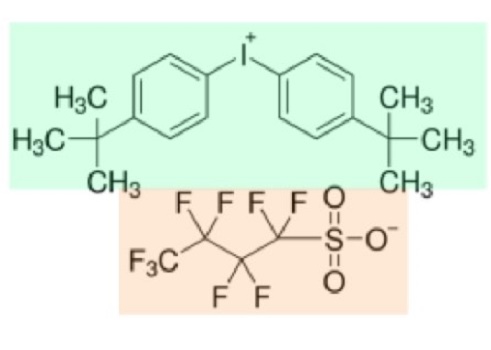| Identification | Back Directory | [Name]
BIS(4-TERT-BUTYLPHENL)IODONIUM PERFLUOR& | [CAS]
194999-85-4 | [Synonyms]
BBI 109
DTBPIO-nF
DTBPI-PFBS
Bis(4-t-butylphenyl)iodonium nonaflate
BIS(4-TERT-BUTYLPHENL)IODONIUM PERFLUOR&
BIS(4-T-BUTYLPHENYL)IODONIUM PERFLUORO-1
Bis(4-tert-butylphenyl)iodonium nonaflate
Di(4-tert-butylphenyl)iodonium perfluorobutanesulfonate
Bis(4-tert-butylphenyl)iodonium perfluorobutanesulfonate
Bis(4-tert-butylphenyl)iodonium nonafluorobutanesulfonate
Di(4-tert-butylphenyl)iodonium perfluoro-1-butanesulfonate
Bis(4-tert-butylphenyl)iodonium perfluoro-1-butanesulfonate electronic grade
Bis(4-tertbutylphenyl)
iodanium,1,1,2,2,3,3,4,
4,4-nonafluorobutane-1-sulfonate
Bis(4-tert-butylphenyl)iodonium perfluoro-1-butanesulfonate electronic grade, >=99%
Bis[4-(1,1-dimethylethyl)phenyl]iodonium salt with 1,1,2,2,3,3,4,4,4-nonafluoro-1-butanesulfonic acid (1:1) | [Molecular Formula]
C20H26I.C4F9O3S | [MDL Number]
MFCD02683473 | [MOL File]
194999-85-4.mol | [Molecular Weight]
692.414 |
| Hazard Information | Back Directory | [Uses]
Cationic photoinitiator. Photoacid generator. | [Research]
To test the reactivity of gaseous 18F-AcF in radiofluorination, bis(4-tert-butylphenyl)iodonium perfluoro-1-butanesulfonate was radiofluorinated with anhydrous 18F-CsF (generated from 18F-AcF and 20 mg Cs2CO3) in 0.3 mL anisole. The results supported the high reactivity for 18F-fluoride derived from 18F-AcF [1].
Bis(4-tert-butylphenyl)iodonium perfluoro-1-butanesulfonate is a photoinitiator (PI). The photoinitiator (PI) mechanisms are radical and cationic. In the cationic PI system, light is absorbed, causing heterolytic and homolytic cleavage that forms a cationic portion (labeled in green) and anionic portion (labeled in pink). The generated molecules are reactive with monomers, forming an acid and free radicals, propagating polymerization[2].
 | [References]
[1] Huailei Jiang , Timothy R. DeGrado, Stephen G. DiMagno . “Production and transport of gaseous 18F-synthons: 18F-acyl fluorides.” Journal of Fluorine Chemistry 180 (2015): Pages 181-185.
[2] Megan Carve, &Donald Wlodkowic. “3D-Printed Chips: Compatibility of Additive Manufacturing Photopolymeric Substrata with Biological Applications.” Micromachines 9 2 (2018). |
|
|